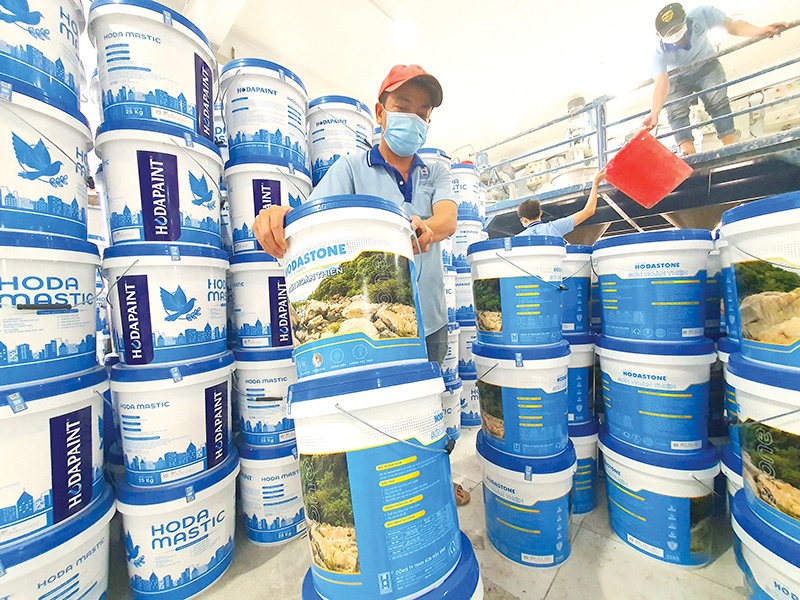Infection rates pressuring production
 |
| Some companies have had to move workers from one department to another to get around absences, photo Le Toan |
Nguyen Hung, director of Huyen Pham, a garment company in Hanoi’s Hai Ba Trung district, said that dozens of workers are confirmed to have been infected every week since the Lunar New Year holiday ended.
“During these weeks, only a few dozen employees are working in the factories, while 70-80 per cent of them are isolating at home. It is quite difficult for us to retain operations and meet order deadlines,” said Hung. The company is handing materials to employees to work at home if patients have no symptoms and feel well.
Nguyen Trung Kien, a member of the board at a factory manufacturing supporting components for export in Hanoi’s Hoai Duc district, said that all workers returned after the holiday but the number of COVID-19 patients has been increasing. They are testing people who have been in close contact with patients, while hoping those isolated can return to work soon to ensure productivity.
“At present, we are recruiting more workers to avoid production disruption, as the number of workers infected is increasing,” Kien calculated.
After the Lunar New Year break in February, garment company Maxcore located in Hanoi’s Ung Hoa district conducted PCR tests for all its 500 workers and detected at least 45 cases of infection. Nguyen Thi Chien, chairwoman of the company’s trade union said, “We have sent people from completed production lines to support the busy ones. Most of them are well-skilled workers, so they can work in various lines.”
Some businesses are facing a labour shortage because many people are worried about the coronavirus outbreak and want to take more time off or work from home, so Chien said trying to recruit others is unavoidable at the moment. “The company is still actively recruiting more workers. After a one-month probationary period, they will be able to sign a long-term contract and pay social insurance premiums,” Chien added.
A company in North Thang Long Industrial Zone in Hanoi is also looking to recruit new employees under short-term or seasonal contracts. The company also has a policy that if employees introduce new workers successfully, they will receive a bonus of VND1.5 million ($65), but the number of recruits remains low compared to the requirements of the company.
To encourage workers back to work, businesses at the zone are lowering hurdles to entry, such as graduation from high school only. Employees can sign a long-term contract and be paid in full social insurance, as well as enjoy basic monthly salary at VND4-6 million ($175-260).
Nguyen Van Giang, chairman of JA Solar Vietnam’s trade union in Bac Giang province’s Quang Chau Industrial Zone, said that the number of infected employees in the company is high but has yet to affect production. The company transferred staff between divisions to overcome the shortages and maintain the production chain.
“According to the provincial directive, despite not testing for all workers, the company still often asks and tests for people with symptoms such as fatigue, cough, and fever,” said Giang.
During this record high of coronavirus infections in the city, enterprises have proposed that Hanoi and surrounding provinces should consider a policy to let healthy patients and their relatives work in isolated production areas to ensure safety as well as maintain production.
According to the Employment Information Centre in Bac Giang, the recruitment demand for workers in the first quarter of 2022 in the province is about 35,000 people, thanks to newly established and expanded businesses.
“Since the Lunar New Year, the centre has recruited nearly 1,000 employees for businesses,” a representative said. “The centre continues to coordinate with provinces to introduce jobs, while actively collaborating with training institutions to build orders between businesses and vocational schools to train a number of technically-skilled workers.”
What the stars mean:
★ Poor ★ ★ Promising ★★★ Good ★★★★ Very good ★★★★★ Exceptional
Related Contents
Latest News
More News
- Businesses ramp up production as year-end orders surge (December 30, 2025 | 10:05)
- Vietjet chairwoman awarded Labour Hero title (December 29, 2025 | 13:06)
- How to unlock ESG value through green innovation (December 29, 2025 | 10:03)
- AI reshapes media and advertising industry (December 29, 2025 | 08:33)
- FPT and GELEX sign deal to develop blockchain tech for global markets (December 29, 2025 | 08:29)
- Vietnam’s GDP forecast to grow by 9 per cent in 2026 (December 29, 2025 | 08:29)
- Women entrepreneurs are key to Vietnam’s economic growth (December 29, 2025 | 08:00)
- Vietnam's top 500 value-creating enterprises announced (December 27, 2025 | 08:00)
- The PAN Group shaping a better future with ESG strategy (December 26, 2025 | 09:00)
- Masan Consumer officially lists on HSX, marking the next phase of value creation (December 25, 2025 | 13:20)

 Tag:
Tag:





















 Mobile Version
Mobile Version